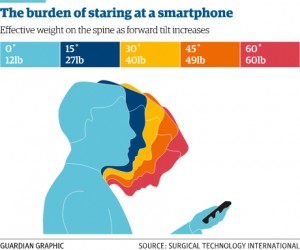How this growing problem is affecting you and your kids.
Would you believe me if I told you that, according to the Kaiser Family Foundation, kids between 8-18 years old spend on average 7.5 hours per day texting, using social media, emailing, and/or playing video games? It’s not just kids, adults are on their smart phones and tablets an average of 2-4 hours per day. This affects us all.

This is a common scene
This is a new societal trend.
With this new trend is coming a new condition, Text Neck. What is text neck?
Text neck is what happens structurally in your neck and upper back/shoulder after hours of texting and smart phone/tablet use on a continual basis. The muscles will start to spasm and become chronically more rigid. The ligaments with stretch, and the spinal bones can become fixated (stuck). These different changes can lead to neck pain, neck stiffness, shoulder pain, headaches, and poor posture.
Our heads are designed to sit directly above our shoulders
Every inch of bending your head forward puts increased stress on your spine (both in your neck and upper back). Research shows that 90% of people bend their neck at least 10 degrees forward while texting and using their tablets.

It’s a law of physics..
When your neck is bent forward 15 degrees, the weight of your head on your spine/shoulders effectively doubles, and the muscles have to work twice as hard to hold your head in place. This is what leads to the aforementioned structural changes and symptoms.
According to the Journal of Applied Psychophysiology and Biofeedback, 83% of people will experience neck pain and hand pain during texting.
Something else to consider, slouching reduces lung capacity up to 30% and contributes to cardiovascular disease, GI problems, depression, and anxiety.
So when your mom used to harp on you for slouching as a kid, “Stand up Straight! Sit up Straight!” She was on to something, and we need to see more of this now more than ever.
Here are some tips to consider to help with this problem.

The solution!
1) Take breaks while you are on your smart phone or tablet, at least every 10 minutes or so.
2) Hold the phone or tablet as close to eye level as possible.
3) Make sure your lower back is up against the chair you are sitting in and that the back of your shoulders are up against the chair as well.
4) Always be aware of your breathing (deep) and posture (upright) while on your smart phones and tablets.
5) Practice self-massage and stretching techniques periodically while on these devices.
6) See your chiropractor.
We can’t eliminate this stressor but we sure can reduce it as well as help our bodies adapt to it better.
-Dr. Ben Fonke, DC
Owner, Fonke Chiropractic and Decompression Center
Cary , NC

Aug 03, 2015 at 10:38 AM
I will surely pass this on to my grandsons and will be more conscious of "text neck" myself.